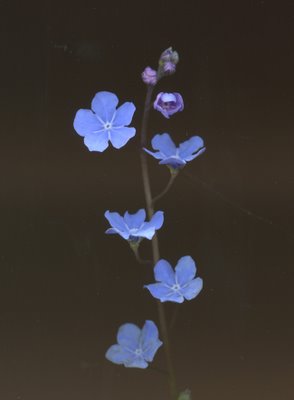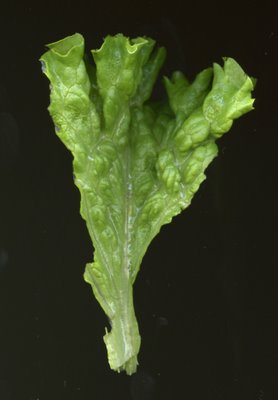That Damn Hedge - Again
Saturday, May 17, 2008
 I wrote about my laurel hedge before here. I have to finish with it today, for yet another year. I have pruned the sides and I have left the top for today. It promises to be sunny and hot and I cannot wait for Rebecca and Lauren to show up by noon. I hope to be finished with the hedge by then so that we can spend time exploring in the garden. We will see which roses are about to bud out and look at some of our recent acquisitions. I have eschewed all those variegated hostas of yore and I purchased yesterday an all green one (with tall and stately leaves and white flowers) called Hosta 'White Triumphator'. One of our new small shrubs is the oddly named Sorbaria sorbifolia because its foliage is similar to a sorbus tree.  The heat will remind me of last year's horse and carriage tour with Rebecca and Rosemary in Mérida, Yucatán. As we clopped on a hot Sunday summer evening we passed boulevards of oleanders. They precipitated a nostalgia for my Buenos Aires garden where we had several. My mother had warned me often about its poisonous nature. But the smell of the oleander is ingrained in the skull of my memory. I smile when Rebecca asks me, "Papi what plants are poisonous in your garden?" She then asks me to show her the location of all our aconitums. They happen to be favourites of Rosemary who has a fondness for any plant with blue flowers.   Who know how many more iced tea, (almost) summer Saturdays we will have with the two girls. But I will try to enjoy today in what promises to be a glorious day in the garden.
Denise Crosby Giggles
Friday, May 16, 2008
One day, quite some time ago, I happened on a photograph of Napoleon's younger brother, Jerome, taken in 1852. And I realized then, with an amazement I have not been able to lessen since: "I am looking at eyes that looked at the Emperor." Sometimes I would mention this amazement, but since no one seemed to share it, nor even understand it (life consists of these little touches of solitude), I forgot about it.
Chapter 1 - Camera Lucida - Reflections on Photography
Roland Barthes

I don't quite remember the circumstances or reasons as to why I faced actress Denise Crosby at the Meridian Hotel in November 1994. I had always been a fan of the original Star Trek with William Shatner and Leonard Nemoy. In fact my first introduction and subsequent addiction to Star Treck was its Mexican version which I saw in Mexico City in the early 70s dubbed into Spanish. Sample, "¡Chihuahua! ¿Donde está el señor Espok?"
The fact that Denise Crosby was the Security Chief Tasha Yar on the first season of Star Trek: The Next Generation did not impress me in the least. I have always hated this pretentious version of what until then was a fun series that did not take itself too seriously. I don't think William Shatner would have ever seriously considered playing a serious Hamlet.
But once I was in the presence of someone who had known Bing Crosby (I felt that same tingle the couple of times I photographed Bob Hope) everything changed. I cringe at my photographs and I cannot understand why I ignored her generous cleavage! But in her presence I felt as if somehow I was George Hurrell taking pictures of Norma Shearer. Crosby had this star presence, this old Hollywood presence.

Crosby giggled when she heard my impersonation of "Capitán Keerk".
A Sad Rebecca - Aida Without Elephants Or Camels
Thursday, May 15, 2008
 It was only in the last years of her life when my grandmother Lolita was in her 70s that she was no longer able to sing. She had forgotten who she was. I remember that she came back from Egypt where she had visited her son (my uncle) Tony. When she deplaned she looked at me and I saw nobody there. Before that whenever anybody in our family or a friend got married Lolita was asked to sing at the wedding. Her signature song was Francisco Santiago's Ave María. It is only in the research of this blog that I have found out that Santiago was born in Santa María, Bulacan in the Philippines in 1919. I had thought Santiago a Spaniard. Well into her late 60s my grandmother's soprano (with coloratura she always told us) was clear and beautiful. She had wanted to be an opera singer. Her father (who had been a baker in Spain) said that people of social standing were never opera singers. But Lolita's sister Buenaventura was allowed to continue in her career as a concert pianist of note in the Philippines. I often wonder what would have happened if my grandmother had followed her star. Seen here is a picture of her in the early 20s when she (a recent widow) and her three children arrived in New York. By the end of the 20s Lolita was working for Winthrop, a pharmaceutical company. Her singing star had dimmed.  From Lolita I learned quite a bit about opera. I might have learned more if I had really been interested. But my ears would open when she told me of performances of Aida at the Met in New York that had live elephants and camels. She told me of going to a theatrical presentation of Ben Hur that had a fight involving galleys at sea (on stage!). Lolita would sing arias for me and some of her favourites were from Aida. It has been a strange two months going with Rebecca to Opera Sushi after her Wednesday ballet class. The selection of operas on DVD at the restaurant are limited so we have been watching Aida in different stages but somehow (while we saw the beginning and the end) we had never seen the triumphant march until yesterday evening. In this 1989 Met version with Plácido Domingo as Radames, Sherrill Milnes as Amonastro, April Millo as Aida and Dolora Zajick as Amneris there are no elephants or camels. But Rebecca did brighten up when the beautiful white horses (with plumes) pranced across the stage. I was struck by melancholy and I watched Rebecca's sad eyes. Her father had forgotten and not taken her last Friday to her ballet's school recital. All her dance mates had been given gold medals. She did not get a medal and her ballet teacher was furious. I grieved at a 10 year-old having to be unhappy. I imagined my grandmother singing the arias from Aida and Rebecca listening rapt at Lolita's performance. I wonder what it is that Rebecca will do some day. Will she be a dancer? A pianist? Or will she end up at a boring job and the very spirit that now shines through her eyes will be muted? At 10 I had no idea of these things. In this 21st century does one have to worry and make decisions much earlier?  I take heart in the knowledge that one of my favourite Vancouver modern dancers, Katy Harris-McLeod, right, did many things in her early life including tree planting and only decided to be a dancer when she was 27. I really did not become a photographer until I came to Vancouver in 1975. I was 33.
Shoulder To Shoulder Gardening & The No Haircut Haircut
Wednesday, May 14, 2008
 IN 1988, two years into our new house with garden, I remember Hilary was studying on the lawn. I was excited as I was taking pictures with my large RB-67 mounted on a tripod. There was a view under the hawthorn tree with tulips and a hosta that was specially handsome. I asked Hilary to take a look through the viewfinder. Her answer was terse, "I am not interested in your garden." And that was that. Perhaps I am trying to get even by giving Rebecca (and recently, Lauren) potted roses, hostas and a rare Rhododendron 'Golfer'. Rebecca tends to her back patio garden and in the spring I show up with bigger pots to transplant the roses. We prune them together. I bring good dirt and some manure. To induce (so they say) new basal shoots on the roses I bring a mixture of magnesium sulphate (epson salts) and alfalfa meal. My guess is that Rebecca's neighbourhood friends must think her strange to have her own garden. The irony here is that my mother gardened and I played a lot in our Buenos Aires garden. I climbed the many plum trees to feast on the fruits but avoided eating from my father's kaki (persimmon) tree. But I had strung a rope from the tree to a wraught iron fence and I zoomed down using a y-shaped branch. While I was too young to be really interested in the garden my mother's plants registered in my memory so we have iris and calla lillies in our Athlone garden to remember my Buenos Aires garden. There are other plants but they will not grow in our climate. So now as Rosemary and I prepare the garden for the Ballet BC House and Garden Tour for the other weekend I think of my mother and how she would love to discover our plants and what she would feel on seeing Rebecca and Lauren play in it. Their mother, Hilary is interested in medicinal herbs but the garden still does not seem to faze her. I might have to wait for her to buy her first house and hope that it has a garden so that I can feel that somehow this family garden interest is being transfered. I also think of my friend W. George Schmid. I wrote about him here. Rosemary is stressed and worried. We brag that our garden is a "shoulder to shoulder" garden. George came up with the term that defines a garden with beds that show no dirt as plants lean on each other and weeds are supressed. Will it be, indeed, a shoulder to shoulded garden by May 24th and 25th when we open the garden? We hope that yesterday and today's rain coupled with the coming sun will make our plants stretch out. Preparing a garden for an opening is much like getting a no-haircut haircut. You want to make the garden look manicured but not manicured recently. Will I mow next Thursday? Time will tell.
On Mexican Pines, Things Evergreen & Cedars Not From Lebanon
Tuesday, May 13, 2008
 Since 1986 I have purchased many dwarf conifers and conifers for the garden. At first my inexperience meant that I had several coniferal deaths. Many of the formerly called chamaecyparis (false cypresses) which have been recently promoted to cupressus (the cypress family)and many pinus (pines) did not like the winter wet and relatively poor drainage of my garden. But many survived and even thrived. Some years ago I purchased three Abies koreana 'Nana' or dwarf Korean firs at a UBC plant sale. The moniker nana was incorrect as the three grew quite tall and the tallest is now 9 ft high. Korean Fir, (Abies koreana; 구상나무, Gusang namu in Korean) is a fir native to the higher mountains of South Korea, including Jeju-do island. What is startling about this conifer is that the underside of the leaves (conifers have leaves even if those needles don't look like them) are silvery white so that in a wind the whole tree shimmers. Startling, too are the upright cones which in spring can be blue, purple of light green. When I married Rosemary some 40 years ago she used to smile when we purchased a Canadian Christmas tree every year. In Spanish all conifers are pinos or pines. The more discerning might know the existence of abetos (abies or firs) or the existence of the extremely Mexico City pollution tolerant juníperos or junipers. Thujas (Western Red Cedars) true cedars and other exotic conifers are all but unknown. All conifers are pinos! In our travels through Mexico in our VW beetle we saw many pines. In the mountains of Oaxaca, in Xalapa, Veracruz and elswhere. It was only here in Vancouver just a few years ago that I learned that Mexico is home to the greatest variety of pine species in the world. It was also in Vancouver that I found out that the Western Red Cedar is not a cedar but a Thuja and that the one in my garden is a Thuja plicata and is not related to cedars but to the pine family. Furthermore I found out that the Douglas Fir is not a fir or (in the proper botanical name an abies) but a pseudo hemlock. Because a Douglas Fir looks somewhat like a hemlock (Tsuga) it is botanically called a Pseudostuga and are all part of the pine family. The useless fact to remember is that a cedar fence is really not a cedar fence (Western Red Cedar or Thuja plicata) and that a true cedar or cedrus is a conifer family from Europe. I have several true cedars in my garden and most are weeping cedars or Cedrus deodara . Also salient, in my opinion, is the knowledge that one should never have a roof with cedar shingles. Years ago when I visited veteran broadcaster Jack Webster in his Saltspring Island retreat he started our barbecue dinner fire with cedar shingles.  As a parting shot I would like to rectify the idea that all conifers are evergreen. There are several that are not. I wrote about one of them here. You can see a branch of Larix kaempferi and its cones here alongside the Abies koreana's cone and a branch showing the silver underside.
Spooning With Rosemary In The Garden
Monday, May 12, 2008
 While I have always enjoyed the comfort of spooning I didn't know what it was called until recently. Yesterday Rosemary and I had an intense day in the garden getting it ready for the Ballet BC Home & Garden Tour 2008. We each work in our areas but we meet to move a plant. She will hold it up so I can see where the roots are and I go at it with a spade. I dig a hole and while Rosemary places the plant in its new spot I fill a bucket with our pond's water to puddle in the plant to reduce the moving shock. It is about now when my friend Donald Hodgson and I would talk hosta on the phone. Hodgson died a few months ago. He had a home wholesale hosta nursery in North Vancouver. He selected tried and true hostas like Hosta montana 'Aureomarginata', Hosta 'Halcyon', Hosta 'Gold Standard' and such stalwart and beautiful species hosta like Hosta nigrescens. He lovingly grew them in large pots and then sold them to the best nurseries in town. Whenever I had a garden tour I would go to his house and he made the exception of selling to me retail so I could "bulk" up some of my hostas that were not doing too well or to fill empty areas of the garden. We talked hosta and we talked on how lovely the garden got to be now when you could discern change and growth from one day to the next. The hosta leaves as the plants unfurled are a tender green and pristine with no slug holes. The first thing Rosemary and I do in the morning is to run to the bathroom window and look out into the back garden. Last night we were exhausted and getting into bed and out of bed (perhaps to get a mug of tea) brought groans as our pained limbs protested movement. No amount of hand cream lessened the roughness of our hands.  But as I gazed upon this tiny flower, Omphalodes cappadocica a plant I would not have noticed anywhere I realize that Rosemary and I spoon in our garden. We fit into each other's tastes and somehow the end result, our garden, is definitely ours.
Lettuce, Mother's Day, Major Dundee & Begoña Palacios
Sunday, May 11, 2008

A seemingly unlikely confluence of events led to today's scanning of a small bit of lettuce. The bit of lettuce is what was left from Rosemary's lettuce, carrot, tomato and celery salad from last night's mother's day dinner. Perhaps it was precipitated when I opened the refrigerator this morning and the remnants of the salad, in a bowl we purchased in Málaga many years, ago fell out and broke.
It all began a couple of weeks ago when Rosemary and I watched in the Turner Classic Movies channel, Sam Peckinpah's 1965 Western Major Dundee with Charlton Heston, Richard Harris, Santa Berger, James Coburn, Slim Pickens and Jim Hutton. Ben Johnson and Warren Oates, two future staples of Peckinpah movies played understated (most uncharacteristic) roles.
And there was also Mexican actress Begoña Palacios.
One of the most often repeated and comforting scene of Peckinpah's Mexican Westerns (The Wild Bunch is certainly another) is a group of rough and tough gringos entering a Mexican village. They soon befriend the villagers and there is a party. There is a cheerful farewell in the end. Nasty Mexican Federales or in this case French imperial forces take revenge on the poor villagers for helping the gringos.
As I watched this fully restored (all the cuts were reinstated in a movie that caused so much uproar because of the director's overbudget and alcoholism) I thought of the fact that Heston went without pay to convince the producers to keep backing the production of the film. But I became melancholic and nostalgic when I noticed Mexican actress Begoña Palacios who convincingly (most demurely) competed with the much more voluptuous Santa Berger who proudly showed her cleavage while strategically pushing her Mexican rebozo to one side.
Begoña Palacios married Sam Peckinpah an extraordinary three times. Here is a short biography:
Begonia Palacios, in spite of being a well-known actress in her native Mexico, was better known as the three-time wife of director Sam Peckinpah. The actress and the director first met when Peckinpah cast her in his 1965 film, Major Dundee. The duo shared an extremely volatile relationship, as evidenced by their unusual three marriages. Palacios and Peckinpah remained close, despite their differences, until his death in 1984 -- he was reportedly journeying to see her when he was stricken, on her birthday no less, with his fatal heart attack. Palacios died in early 2000 and her ashes were scattered off the shores of Malibu, CA, the same location where Peckinpah's ashes were strewn. ~ Ryan Shriver, All Movie Guide
The next event that has led to the bit of lettuce happened yesterday in the afternoon when Rebecca asked me to play any music of my choice. I chose Aaron Copland's Lincoln Portrait directed by Maurice Abravanel and the Utah Symphony Orchestra. The piece was narrated by Charlton Heston. Rebecca had never heard of Heston, Ben Hur, A Touch of Evil and, much less, Major Dundee. We will have to see Ben Hur together. But Rebecca did comment that Heston's voice was most interesting.
For mother's day dinner the chicken I was making in the outdoor barbecue had to be finished in the oven when the gas was exhausted. I placed the chicken with the basting liquid in a pyrex dish and the result was a resounding and juicy success. After a dessert of apple flambé (with Pernod, butter and cream) we watched Rossini's Ghost from the series called The Composers' Specials . When Hilary was about to leave she said, "This has been an unusual mother's day."
I thought about it overnight.
Begoña Palacios would have been called "a lechugita" (a small head of lettuce) by Mexicans to describe her vuluptuous and lively nature. But better still she would be called "a mamacita" (little mother). Mexicans have a complex relationship with motherhood, and with diverse meanings of the word. This complex relationship was best explained by Mexican writer/poet/diplomant Octavio Paz in his book (1950) El Laberinto de la Soledad (The Labyrinth of Solitude).
It all began when Doña Marina (as Spaniards affectionately call her) or La Malinche, the disdainful Mexican epithet "sold out" her country by translating for Hernan Cortez and then complicating it even more by bedding the conquistador and having a son. To this day a "malinchista" is a Mexican who prefers foreign goods.
Mexicans have some strange expressions related to mothers and motherhood. "My mamacita" can be an endearing term describing one's dear mother or in most cases one's dear mistress. A mamacita is a lechugita , a beautiful young or not so young woman. When Rosemary would walk home from teaching English to our apartment in Mexico City's Zona Rosa, bricklayers and construction workers would shout "¡Mamacita!" at her. I don't blame them. Rosemary had beautiful legs and wore extra short mini skirts. That she was close to 8 months pregnant at the time had no bearing.
A papacito (or little father) has nothing to do with fatherhood and all to do with a man who is cool and can pick up women. A papacito has many mamacitas.
The most complex term involving the word mother in Mexico is madre or mother. "Te voy a dar en la madre." which losely translates to "I will give it to you in your mother, " means, "I am going to fu-- you over, and get even with you." Octavio Paz mentions the curious fact that this fictitious place, this abstract place (the mother in you that I am going to get at) is nowhere and cannot be found anywhere. Mexican's will commonly utter, "Me dieron en la madre,", when they suffer a financial problem, had an automobile accident or failed a test in school.
Yet "a toda madre" (sort of all mother) is used to denote something fantastic. ¡Vancouver "es a toda madre! would mean that Vancouver is a happening place. But "no vale madre" (it's not worth a mother) means that something is worthless and shoddy. To confuse it further, "Vancouver es un lugar padre," (Vancouver is a father place) means the same thing as !Vancouver es a toda madre!
Such is the alternate almost obscene meaning of madre and mamacita that Mexicans reserve another variant "madrecita" (little mother) which has not sexual meaning and is a pure, long sufferning and kind mother.
Such is the Mexican obsession with motherhood that the ultimate insult is to state that your oponent should have sex with his mother. The perennial American (Frank Sinatra used it a lot) finish to a song "ta, ta, ta-ta-ta - tá-tá" means just that. For many years Mexicans would honk their car horns to insult those with lesser motoring skills. Expensive fines were instituted by the authorities to counter this vehicular obscenity. So ever-so-quick Mexicans simply honk their horn twice, tá, tá. Everybody knows this is not an endearing motherly term.
And yes, Begoña Palacios in Major Dundee, is a lechugita, a mamacita. Her performance is "a toda madre" and Charlton Heston "les dió en la madre a los Franceses" soundly defeated the Frenchies. In fact since mother's day in Mexico is always celebrated on May 10th and the Mexican defeat of the imperial French forces in Puebla happened on May 5th, the Puebla holiday is sometimes called "La Media Madre" or "half mother".
¡Begoña Palacios, mamacita, mamacita!
|





















